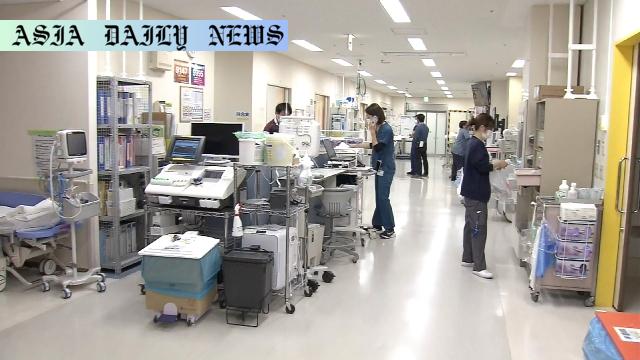Japanese hospitals face overwhelming pressure as flu cases surge, impacting medical capacities and staff availability.
Japanese hospitals are grappling with rising flu cases causing capacity issues.
Staff shortages arise as medical workers also get infected.
Over 40% of Yokohama’s emergency hospitals reported being full.
Hospital officials stress the need for systemic solutions.

Hospitals in Japan are facing significant challenges as they contend with an influx of influenza cases, leading to strained resources and capacities. Medical institutions, particularly those handling emergency cases, are overwhelmed by a surge in patients presenting with high fever and related flu symptoms. The situation has been particularly acute since mid-December, with facilities in cities like Yokohama near Tokyo highlighting the crisis.
At Saiseikai Yokohamashi Tobu Hospital, for instance, the number of emergency patients has surged to 1.5 times the usual capacity. The hospital’s 550-bed capacity is nearly at its limit, burdened further by long-term hospitalizations of elderly individuals and those with chronic illnesses. Additionally, staff shortages are compounding the problem, as the flu spreads to healthcare workers, including doctors and nurses. This has stretched the hospital’s ability to provide care, leading to a temporary closure for accepting emergency patients last Friday, except for those requiring urgent surgeries. Although the hospital has resumed accepting patients, the crisis continues to loom large.
This widespread pressure has mirrored across Yokohama city, where over 40% of emergency medical institutions reported full occupancy on the same day. The head of the emergency medical center at Saiseikai Yokohamashi Tobu Hospital, Shimizu Masayuki, highlighted the critical need for a coordinated and systemic strategy. Hospitals not only need to manage flu cases but also ensure adequate care for all other unrelated emergencies. Shimizu emphasized the importance of collaborative efforts involving administrative authorities and local medical institutions to address the ongoing crisis effectively.
The broader implications of this surge are significant. Overcrowded hospitals not only affect the quality of care but also pose the potential risk of turning medical facilities into hotbeds for infection, further endangering patients and healthcare workers alike. As medical institutions navigate these challenges, attention is also being drawn to the need for greater public health measures to curb the spread of influenza, reduce hospital admissions, and ensure that critical resources are reserved for the most vulnerable populations.
Influenza is a recurring seasonal concern, but its intersection with other respiratory illnesses and global health challenges like the ongoing threat of COVID-19 underlines the urgency for robust healthcare preparedness. Public health campaigns and vaccination drives remain vital tools in reducing the strain on medical facilities. Hospitals, for their part, must also look into contingency plans, such as expanding emergency services, improving bed availability, and undertaking infection control measures to safeguard their staff.
In the long term, the current crisis serves as a wake-up call for Japan and other regions to reevaluate their healthcare infrastructures and invest in improving pandemic and epidemic preparedness plans. With the emergence of viral illnesses becoming increasingly frequent, ensuring resilience at the community and institutional levels is a priority that cannot be ignored.
As Japan’s medical system grapples with this strain, it is clear that comprehensive action is needed—not just in the form of acute care responses but also through strategic initiatives that unite governments, medical professionals, and the public to tackle such issues proactively.



Commentary
The current situation in Japan, where hospitals are buckling under the strain of increased influenza cases, points to several critical issues within healthcare systems globally. While seasonal outbreaks of the flu are predictable, the current crisis underscores how even well-structured systems can rapidly become overwhelmed when preparedness is lacking or when resources are stretched thin by overlapping health challenges.
One of the most alarming aspects of this scenario is the impact not just on patients but also on healthcare staff. The infection of doctors and nurses creates a vicious cycle—less staff means compromised patient care, which in turn increases the workload on remaining staff, further stressing the system. Over time, this could lead to burnout and a diminished workforce, further compounding the crisis. It is high time for healthcare facilities to strengthen measures like regular health checks, proper protective equipment, and strict infection control protocols to shield those on the frontlines.
Another notable issue is the long-term hospitalization of vulnerable groups such as the elderly and those with chronic illnesses, which limits bed availability for incoming emergencies. The overlapping needs of such patient groups with those severely affected by seasonal influenza demand more innovative solutions. Governments and local administrators must invest in auxiliary care facilities where non-critical patients can recuperate, thereby freeing up hospital beds for acute conditions.
This crisis also raises questions about the role of public health policy in mitigating strain on hospitals. Public awareness campaigns emphasizing the importance of flu vaccinations and hygiene practices could significantly reduce the number of infections during peak seasons. Additionally, better integration of technology, such as predictive modeling tools, could help healthcare providers anticipate and prepare for surges in patient numbers well in advance.
On a broader scale, Japan’s current challenge offers lessons for the global community. The COVID-19 pandemic has already highlighted weaknesses in healthcare infrastructures and the need for greater investment in health systems. Influenza, though less fatal, provides another stark example of how quickly a healthcare system can falter under routine pressures. Countries must take this as an opportunity to revisit their healthcare policies, improve funding, and enhance resilience against both seasonal and unexpected health crises.
In conclusion, the influenza crisis in Japan is a stark reminder of the importance of proactive planning, resource allocation, and public health prioritization. The path forward lies in collaboration—not just within the healthcare industry, but across governmental and community partnerships—to ensure that resources are both abundant and accessible. It is only through collective action that we can hope to safeguard not just individual communities but also the healthcare institutions that serve as the backbone of society.